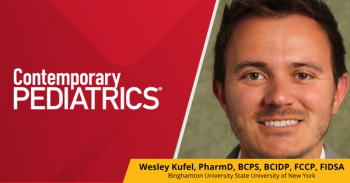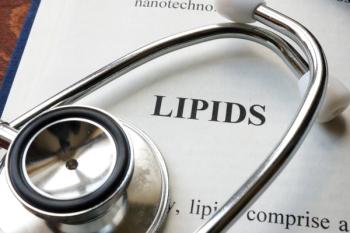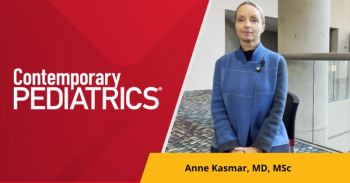
- Consultant for Pediatricians Vol 8 No 1
- Volume 8
- Issue 1
Atypical Kawasaki Disease and Hepatosplenomegaly
A 4-month-old boy was transferred to our center from a community care hospital because of persistent fever (temperature up to 39.4°C [103°F]) of 5 days’ duration. He also had decreased activity, increased irritability, occasional vomiting after feedings, and a few episodes of loose stool.
A 4-month-old boy was transferred to our center from a community care hospital because of persistent fever (temperature up to 39.4°C [103°F]) of 5 days’ duration. He also had decreased activity, increased irritability, occasional vomiting after feedings, and a few episodes of loose stool. Results of a complete sepsis workup, including blood, urine, and cerebrospinal fluid cultures, were negative. Birth and medical histories were unremarkable.
The infant was irritable on examination. His hands and feet were swollen and erythematous (although this finding resolved the next morning). Massive hepatomegaly and mild splenomegaly were also noted. The remainder of the physical findings were unremarkable. Because of the concern for malignancy, macrophage activation syndrome, and infectious causes, oncology/hematology and infectious diseases specialists were consulted.
The hemoglobin level was 7.3 g/dL; white blood cell (WBC) count, 16,300/μL; platelet count, 190,000/μL (which increased 4 days later to 488,000/μL); C-reactive protein (CRP) level, 27.9 mg/dL; erythrocyte sedimentation rate (ESR), 87 mm/h; and albumin level, 2.6 g/dL. Serum electrolyte and liver enzyme levels were normal. Results of stool cultures, tests for Clostridium difficile toxins, ova and parasite examination, and rotavirus assay were negative. Results of serological testing for Epstein-Barr virus, cytomegalovirus, parvovirus, herpes simplex virus, and Toxoplasma-and of a rapid plasma reagin test-were also negative. An abdominal ultrasonogram showed a slightly enlarged spleen and an enlarged liver that extended up to the lower pole of the right kidney.
Over the next 4 days, the child remained febrile and irritable; a rheumatology specialist was consulted for the possibility of systemic-onset juvenile rheumatoid arthritis. Test results for antinuclear antibody and anti-dsDNA antibodies were negative; complement levels were normal. The WBC count had increased to 26,100/μL, with 76% neutrophils and 5% bands. A workup for macrophage activation syndrome, including ferritin and triglyceride levels, was normal.
On further questioning, the parents reported that the child had had a diffuse nonspecific rash during the first day of illness. In view of the persistent fever and irritability, the history of transient rash, the swollen hands and feet, and elevated inflammatory markers, as well as the exclusion of other possible explanations for these findings (ie, scarlet fever, toxic shock syndrome, staphylococcal scalded skin syndrome, Stevens-Johnson syndrome, and drug hypersensitivity reaction), Kawasaki disease was suspected.
On day 9 of the infant’s illness, a single dose of intravenous immunoglobulin (IVIG) was given and highdose aspirin, 80 to 100 mg/kg/d, was started; a baseline echocardiogram was normal. Within 24 hours of the administration of the IVIG, the fever subsided, irritability resolved, and inflammatory markers decreased.
At the 2-week cardiology clinic follow-up, the patient was found to have coronary artery abnormalities, which confirmed the diagnosis. He underwent a cardiac catheterization procedure; coronary angiography showed a fusiform aneurysm of the right coronary artery (Figure). The other coronary arteries were normal. A second abdominal ultrasonogram showed resolution of the hepatosplenomegaly; the inflammatory markers had normalized completely. The patient’s parents were instructed to continue lowdose aspirin indefinitely.
KAWASAKI DISEASE: AN OVERVIEW
Kawasaki disease, a febrile multisystem vasculitis that can result in coronary artery abnormalities, has emerged as the most common cause of acquired heart disease among children in the developed world. Prompt diagnosis and early treatment with IVIG and high-dose aspirin reduces the incidence of coronary artery aneurysms-the most important long-term sequelae of Kawasaki disease-from 25% to about 3%.1,2
There is no specific diagnostic test for Kawasaki disease. Diagnosis is based on the clinical manifestations, which include fever of 5 or more days’ duration and at least 4 of the following 5 characteristics:
•Bilateral conjunctival injection.
•Mucous membrane changes with injected or fissured lips, injected pharynx, or “strawberry” tongue.
•Extremity changes with erythema of the palms or soles, edema of the hands or feet or, later on, generalized or periungual desquamation.
•Polymorphous exanthem, usually a diffuse maculopapular eruption. Occasionally, a urticarial exanthem, scarlatiniform rash, erythroderma, or erythema multiforme–like rash or, rarely, a fine micropustular eruption may be seen.
•Cervical lymphadenopathy (with 1 node larger than 1.5 cm).3
The diagnosis can be a challenge when patients do not meet-or do not appear to meet-the abovecriteria.4 Such patients fall into 3 groups:
•Patients in whom clinical features are not present at the same time; some of the features may even resolve before the patient is brought to medical attention.4,5 Thorough questioning and watchful waiting is sometimes necessary before a diagnosis can be made.
•Patients with incomplete Kawasaki disease-those who have fewer than 4 of the characteristic features.4,6,7
•Patients whose prominent presenting symptoms obscure other classical signs (atypical Kawasaki disease).6
In some patients, the clinical picture may be dominated by a less common manifestation of Kawasaki disease, such as uvulitis, supraglottitis, or hepatomegaly and splenomegaly-as in the child in this case.1,8 Young infants are more likely than older children to present with incomplete or atypical features.9,10 Thus, erroneous or late diagnosis is more common in very young patients.
Supporting laboratory findings may help heighten the suspicion of incomplete or atypical Kawasaki disease.4 These may include a moderately to markedly elevated CRP level of more than 3 mg/dL or ESR of more than 40 mm/h, anemia for age, platelet counts of more than 450,000/μL in patients evaluated after day 7 of illness, mild to moderate elevations in serum transaminases, mild hyperbilirubinemia, albumin levels of less than 3.0 g/dL, and mild to moderate sterile pyuria. When 3 or more of these laboratory findings are present, obtain an echocardiogram and treat the patient with IVIG. For patients with fewer than 3 of these findings who remain febrile, obtain an echocardiogram and seek consultation with a Kawasaki disease expert.4
HEPATOSPLENOMEGALY IN KAWASAKI DISEASE
Although hepatobiliary dysfunction is common in Kawasaki disease, hepatomegaly and splenomegaly are rare (present in only 14.5% and 3% of cases, respectively), according to one study.11 Other cases of Kawasaki disease with hepatosplenomegaly involve patients in whom associated hemophagocytic syndrome developed.12 However, in no case of Kawasaki disease in the English medical literature have hepatomegaly and splenomegaly been the predominant findings on presentation.
The pathogenesis of the hepatosplenomegaly in Kawasaki disease is unknown. One study of 30 autopsied cases suggested that the pathogenesis of hepatomegaly in Kawasaki disease may involve inflammation of the portal areas.13
TREATMENT
A single infusion of IVIG, 2 g/kg, given within the first 10 days of illness, is ideal. IVIG may be given after the 10th day in some circumstances, such as when the diagnosis was missed initially or if the child has ongoing systemic inflammation (persistent fever or elevated ESR or CRP level). In children who do not respond to a single dose of IVIG-those with persistent or recrudescent fever of 36 hours or more-(about 10% of patients), a second dose is recommended.14 For refractory cases (no response after 2 doses of IVIG), consider administration of pulse corticosteroid therapy or infliximab treatment.4
After day 14 of illness and about 48 to 72 hours after fever cessation, the aspirin dosage is decreased to 3 to 6 mg/kg/d. Low-dose aspirin is maintained until inflammatory markers and the platelet count normalize and echocardiographic evaluations show no evidence of coronary changes, usually 6 to 8 weeks after the onset of illness. In children in whom coronary abnormalities develop, antiplatelet therapy may be continued indefinitely. These patients require long-term follow-up with a cardiologist and should receive annual influenza vaccine.4
Because IVIG contains antibodies to measles and varicella, immunizations for these diseases should be deferred for 11 months after treatment in children with Kawasaki disease.
References:
REFERENCES:
1.
Newburger JW, Takahashi M, Burns JC, et al. The treatment of Kawasaki syndrome with intravenous gamma globulin.
N Engl J Med.
1986;315:341-347.
2. Terai M, Shulman ST. Prevalence of coronary artery abnormalities in Kawasaki disease is highly dependent on gamma globulin dose but independent of salicylate dose.
J Pediatr.
1997;131:888-893.
3.
Dajani AS, Taubert KA, Gerber MA, et al. Diagnosis and therapy of Kawasaki disease in children.
Circulation.
1993;87:1776-1780.
4.
Newburger JW, Takahashi M, Gerber MA, et al. Diagnosis, treatment, and long-term management of Kawasaki disease: a statement for health professionals from the Committee on Rheumatic Fever, Endocarditis, and Kawasaki Disease, Council on Cardiovascular Disease in the Young, American Heart Association [published correction appears in
Pediatrics.
2005;115:1118].
Pediatrics.
2004;114:1708-1733.
5.
Anderson MS, Todd JK, Glodé MP. Delayed diagnosis of Kawasaki syndrome: an analysis of the problem.
Pediatrics.
2005;115:e428-e433.
6.
Park AH, Batchra N, Rowley A, Hotaling A. Patterns of Kawasaki syndrome presentation.
Int J Pediatr Otorhinolaryngol.
1997;40:41-50.
7.
Witt MT, Minich LL, Bohnsack JF, Young PC. Kawasaki disease: more patients are being diagnosed who do not meet American Heart Association criteria.
Pediatrics.
1999;104:e10.
8.
Kazi A, Gauthier M, Lebel MH, et al. Uvulitis and supraglottitis: early manifestations of Kawasaki disease.
J Pediatr.
1992;120:564-567.
9.
Chang FY, Hwang B, Chen SJ, et al. Characteristics of Kawasaki disease in infants younger than six months of age.
Pediatr Infect Dis J.
2006;25:241-244.
10. Joffe A, Kabani A, Jadavji T. Atypical and complicated Kawasaki disease in infants. Do we need criteria?
West J Med.
1995;162:322-327.
11
. Burns JC, Mason WH, Glode MP, et al. Clinical and epidemiologic characteristics of patients referred for evaluation of possible Kawasaki disease. United States Multicenter Kawasaki Disease Study Group.
J Pediatr.
1991;118:680-686.
12.
Palazzi DL, McClain KL, Kaplan SL. Hemophagocytic syndrome after Kawasaki disease.
Pediatr Infect Dis J.
2003;22:663-666.
13.
Ohshio G, Furukawa F, Fujiwara H, Hamashima Y. Hepatomegaly and splenomegaly in Kawasaki disease.
Pediatr Pathol.
1985;4:257-264.
14.
Wallace CA, French JW, Kahn SJ, Sherry DD. Initial intravenous gammaglobulin treatment failure in Kawasaki disease.
Pediatrics.
2000;105:E78.
Articles in this issue
almost 17 years ago
Blisters on Infant's Hands and Feetalmost 17 years ago
Images of Hypertrichosisalmost 17 years ago
How to Stop the Bullyingalmost 17 years ago
Leg Size Asymmetry in a Toddleralmost 17 years ago
Polydactyly of the Hands and Feetalmost 17 years ago
Parent Coach: New Feature Tackles Tough QuestionsNewsletter
Access practical, evidence-based guidance to support better care for our youngest patients. Join our email list for the latest clinical updates.














